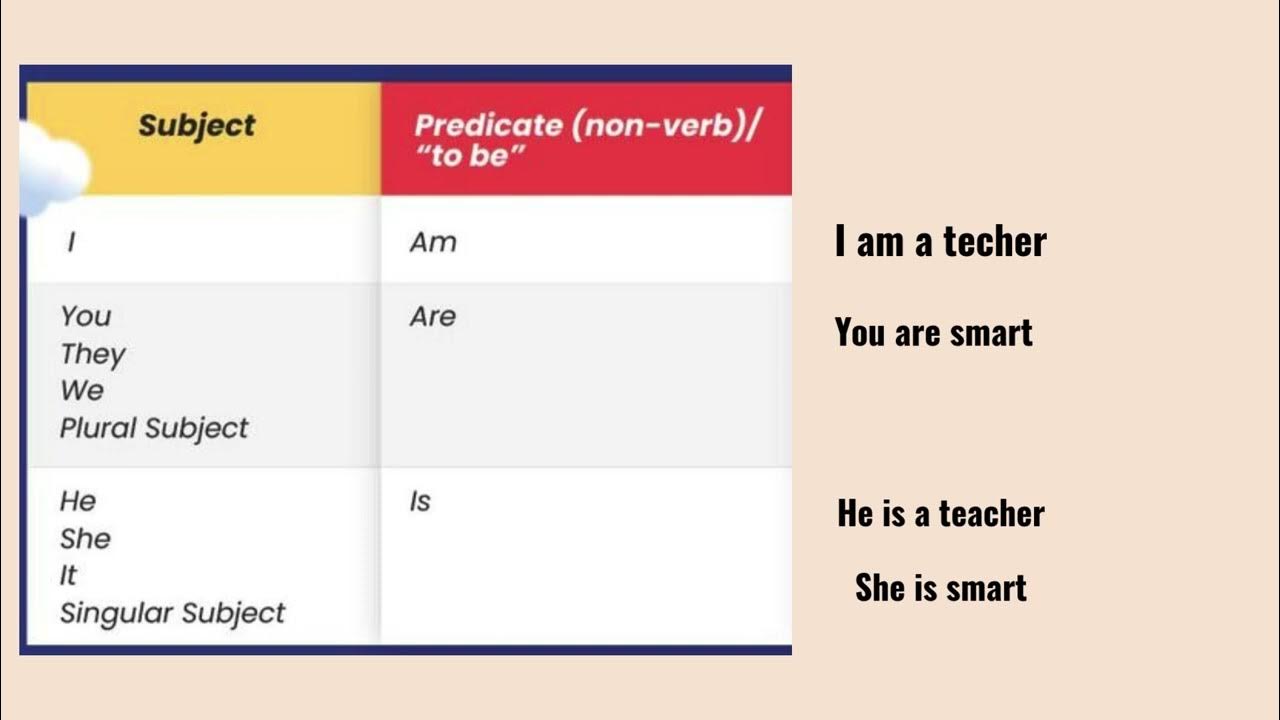Materi Self Introduction (Using 'Be' and ' Have') Mata Pelajaran Bahasa Inggris X
Summary
TLDRThis video script features an engaging lesson on using the English language, focusing on the present tense, auxiliary verbs, and sentence structures like affirmative, negative, and interrogative forms. The teacher guides students through various examples, exercises, and explanations of grammar concepts, including pronouns, 'is,' 'are,' and 'have.' The lesson emphasizes understanding basic sentence construction in English and practicing through interactive examples. The instructor also integrates cultural elements like a prayer and encourages active participation and feedback through YouTube comments and other communication channels. Overall, it is an educational and interactive approach to learning English grammar.
Takeaways
- 😀 The lesson focuses on using 'is,' 'am,' 'are,' 'have,' and 'has' in the present tense for both singular and plural subjects.
- 😀 Students are introduced to the difference between affirmative, negative, and interrogative sentence structures.
- 😀 'Is' is used for singular subjects (he, she, it), while 'am' is for 'I,' and 'are' is for plural subjects (you, we, they).
- 😀 The use of 'have' and 'has' is explained, where 'has' is used for third-person singular, and 'have' is used for plural subjects and first and second-person singular.
- 😀 Students are encouraged to complete exercises with sentences like 'I am a teacher,' 'She has a pen,' and 'They are students.'
- 😀 The teacher emphasizes the importance of paying attention to pronouns (I, you, he, she, we, they) when choosing the correct verb form.
- 😀 Negative sentences are formed by adding 'not' after the verb, such as 'I am not a teacher' or 'He is not happy.'
- 😀 Interrogative sentences are formed by inverting the subject and verb, e.g., 'Are you a teacher?' or 'Is he ready?'
- 😀 The teacher includes practical examples in Indonesian and English to help students understand and practice the grammar concepts.
- 😀 At the end of the lesson, a prayer is recited for knowledge, understanding, and guidance, highlighting a focus on spiritual and educational growth.
Q & A
What is the main topic of the lesson in the transcript?
-The main topic of the lesson is the use of auxiliary verbs 'is,' 'am,' 'are,' and 'have' in present tense sentences, with an emphasis on understanding their correct application in English grammar.
What does the instructor begin with at the start of the class?
-The instructor starts the class by greeting the students with a Muslim prayer ('Bismillahirrohmanirrohim') and introduces the learning objectives for the session.
What are the learning objectives outlined in the video?
-The learning objectives include identifying and analyzing present tense sentences, especially those using 'is,' 'am,' 'are,' and 'have,' and understanding their grammatical structures.
What prayer does the instructor lead before the lesson begins?
-The instructor leads a prayer that asks for knowledge, understanding, and the guidance of Allah, emphasizing the importance of learning and being guided to the truth.
What is explained about the verb 'is' in the video?
-'Is' is explained as a form of the auxiliary verb used with singular third-person subjects, such as he, she, it, or singular nouns like 'the teacher.' It indicates the present tense.
What is the purpose of using auxiliary verbs like 'is,' 'am,' and 'are' in present tense sentences?
-Auxiliary verbs like 'is,' 'am,' and 'are' are used to form present tense sentences, particularly when no main verb is present. They help express actions, conditions, or states of being in the present.
How is the verb 'have' used differently from 'is' in the lesson?
-'Have' is used to show possession or ownership, while 'is' is used to describe states or conditions. The lesson also discusses how 'have' and 'has' are used based on subject pronouns.
What is the difference between the auxiliary verbs 'have' and 'has'?
-'Have' is used with plural subjects or the pronouns 'I,' 'you,' 'we,' and 'they.' 'Has' is used with singular third-person subjects like 'he,' 'she,' 'it,' or singular nouns.
What are some examples given in the lesson to demonstrate 'have' and 'has' in use?
-Examples include 'I have a book' (showing possession), 'She has a cat' (demonstrating possession with a singular subject), and 'They have cars' (with a plural subject).
What is the exercise in the lesson about?
-The exercise involves filling in blanks with the correct form of the auxiliary verbs 'is,' 'am,' 'are,' 'have,' or 'has,' based on the sentence context. The students practice these verbs in different sentence structures.
Outlines

This section is available to paid users only. Please upgrade to access this part.
Upgrade NowMindmap

This section is available to paid users only. Please upgrade to access this part.
Upgrade NowKeywords

This section is available to paid users only. Please upgrade to access this part.
Upgrade NowHighlights

This section is available to paid users only. Please upgrade to access this part.
Upgrade NowTranscripts

This section is available to paid users only. Please upgrade to access this part.
Upgrade NowBrowse More Related Video

Yuk belajar SIMPLE PRESENT TENSE | Bahasa Inggris untuk Pemula

Modal Verbs | MUST CAN WOULD SHOULD MIGHT WILL COULD SHALL MAY

SIMPLE PRESENT (NEGATIVE & INTERROGATIVE)

SIMPLE PRESENT TENSE - NOMINAL VERBAL LENGKAP (fungsi, formula, tobe, ciri-ciri, latihan soal)

Simple Past Tense: Affirmative, Negative and Interrogative Sentence

ENGLISH Language Course2
5.0 / 5 (0 votes)